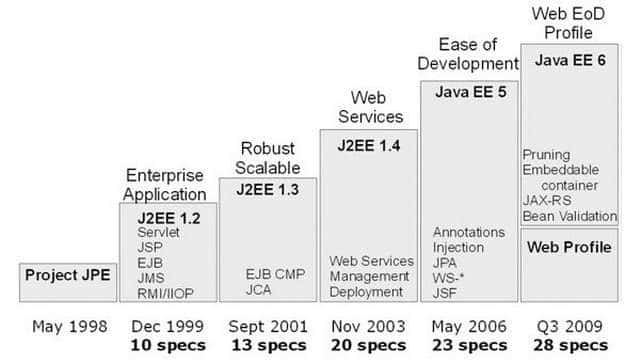As you already know Java EE platform is a much more mature platform for developing distributed enterprise software applications. Since its release (in 1999) the adaption of the developers and the usability of the customers increase incredibly contrasting with the other major platforms. So far so good, different kinds of innovations were implemented such as frameworks, tools, deployment capabilities and also the community around itself is growing day by day. So the fact that is it’s now a ground breaking technology/platform in the industry.
Bit Of History
After ten year it is in a major position to talk about of it earlier releases, namely referred as J2EE (pronounced J-two-ey). First version of J2EE is the version 1.2 developed by Sun, was released in 1999 as an umbrella specification containing ten Java Specification Requests (JSRs). At that time people were talking about CORBA, so J2EE 1.2 was created with distributed systems in mind. Enterprise Java Beans (EJBs) were introduced with support for remote stateful and stateless service objects, and optional support for persistent objects (entity beans). They were built on a transactional and distributed component model using RMI-IIOP (Remote Method Invocation–Internet Inter-ORB Protocol) as the underlying protocol. The web tier had servlets and JavaServer Pages (JSPs), and JMS was used for sending messages.

What’s New On Java EE 6
The specification for the Java EE 6 was finalized on December 2009, bringing new features and constrains to the world of enterprise development. The most garrulous feature is profile based approach for development of web applications; mainly there are two profile types, Web Profile for development of light weight typical web applications at this stage some of the middle tire technologies such as EJB/persistence are limited and completely not applicable for the sake of ease of development and to lighter up the development/deployment process. The second profile or the Java EE 6 standard implementation is for large scale enterprise and distributed web application/solutions. Also the specification expert team has brought the ease of development form the previous version of Java EE (5.0) with the combination of plug-ability. Let’s look at the new features as a quick overview.
- Java API for RESTful Web Services (JAX-RS) 1.1
- Enterprise JavaBeans 3.1 (EJB 3.1 Lite for web profile)
- Java Servlet 3.0
- JavaServer Pages 2.2/Expression Language 2.2
- JavaServer Faces 2.0
- Java EE Connector Architecture 1.6
- Bean Validation 1.0
- Dependency Injection for Java 1.0
This is just a quick overview you can get the full detailed feature list and the related specifications from here.
Glassfish v3
Along with Java EE 6 the topic Glassfish should be combined because it’s the first application server that released in relatively to the Java EE 6 and it’s one of two supporting application servers for the Java EE 6 platform, the other application server is called TMAX JEUS 7. As per technical experts the Glassfish development team had to rebuild the Glassfish v3 form the scratch to support Java EE 6 profile based architecture and other major capabilities like EJB 3 Lite. Glassfish has served many customers in the past and present, so this version of Glassfish will probably get the attention from the industry. Also the SUN corporate services and technical support is there for anytime to help the developers and the customers with their problems.
Summery
When a company develops a Java application and needs to add enterprise features such as transaction management, security, concurrency, or messaging, Java EE is an attractive choice. It is standard, components are deployed to different a container, which gives you many services, and it works with various protocols. Java EE 6 follows the path of its previous version by adding ease of use to the web tier. This version of the platform is lighter (thanks to pruning, profiles, and EJB Lite), easier to use (no need for interfaces on EJBs or annotations on the web tier), richer (it includes new specifications and new features), and more portable (it includes Standardized embedded EJB container and allows for JNDI names).
Reference
- Goncalves, A. (2009). Beginning JavaTM EE 6 Platform with GlassFishTM 3: From Novice to Professional. Apress.
- Java EE 6 Technologies. (2010, February). Retrieved February 2010, from Sun.com: http://java.sun.com/javaee/technologies/
Tags: #JAVA
